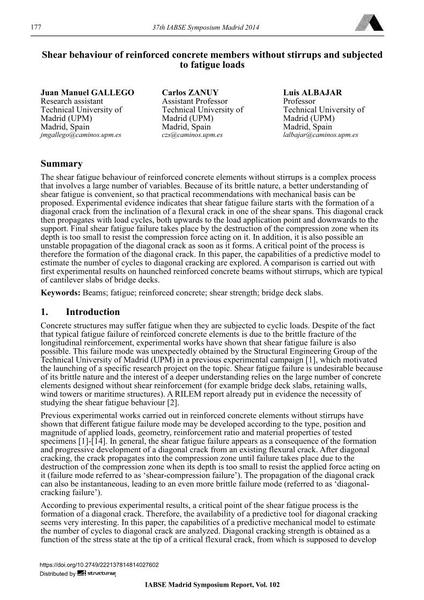Shear behaviour of reinforced concrete members without stirrups and subjected to fatigue loads

|
|
|||||||||||
Bibliografische Angaben
| Autor(en): |
Juan Manuel Gallego
Carlos Zanuy Luis Albajar |
||||
|---|---|---|---|---|---|
| Medium: | Tagungsbeitrag | ||||
| Sprache(n): | Englisch | ||||
| Tagung: | IABSE Symposium: Engineering for Progress, Nature and People, Madrid, Spain, 3-5 September 2014 | ||||
| Veröffentlicht in: | IABSE Symposium Madrid 2014 | ||||
|
|||||
| Seite(n): | 177-184 | ||||
| Anzahl der Seiten (im PDF): | 8 | ||||
| Jahr: | 2014 | ||||
| DOI: | 10.2749/222137814814027602 | ||||
| Abstrakt: |
The shear fatigue behaviour of reinforced concrete elements without stirrups is a complex process that involves a large number of variables. Because of its brittle nature, a better understanding of shear fatigue is convenient, so that practical recommendations with mechanical basis can be proposed. Experimental evidence indicates that shear fatigue failure starts with the formation of a diagonal crack from the inclination of a flexural crack in one of the shear spans. This diagonal crack then propagates with load cycles, both upwards to the load application point and downwards to the support. Final shear fatigue failure takes place by the destruction of the compression zone when its depth is too small to resist the compression force acting on it. In addition, it is also possible an unstable propagation of the diagonal crack as soon as it forms. A critical point of the process is therefore the formation of the diagonal crack. In this paper, the capabilities of a predictive model to estimate the number of cycles to diagonal cracking are explored. A comparison is carried out with first experimental results on haunched reinforced concrete beams without stirrups, which are typical of cantilever slabs of bridge decks. |
||||
| Stichwörter: |
Ermüdung Scherfestigkeit Stahlbeton Balken
|
||||
